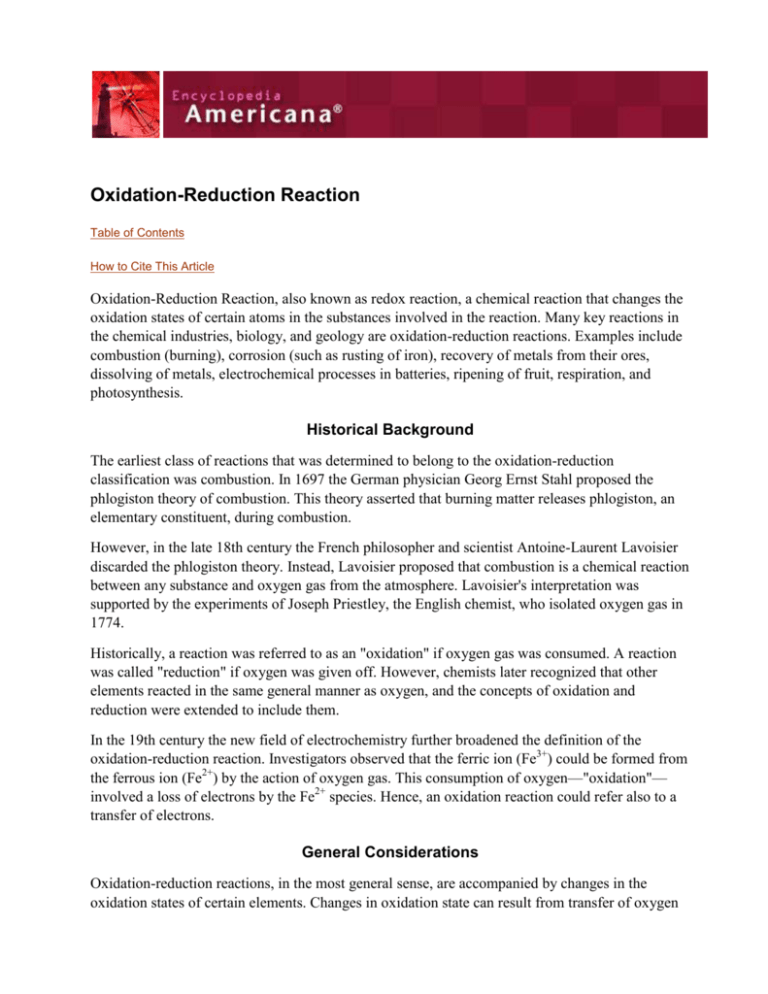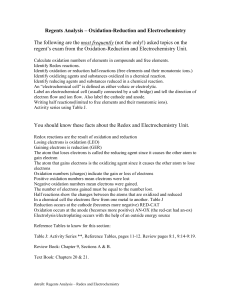
Oxidation-Reduction Reaction
Table of Contents
How to Cite This Article
Oxidation-Reduction Reaction, also known as redox reaction, a chemical reaction that changes the
oxidation states of certain atoms in the substances involved in the reaction. Many key reactions in
the chemical industries, biology, and geology are oxidation-reduction reactions. Examples include
combustion (burning), corrosion (such as rusting of iron), recovery of metals from their ores,
dissolving of metals, electrochemical processes in batteries, ripening of fruit, respiration, and
photosynthesis.
Historical Background
The earliest class of reactions that was determined to belong to the oxidation-reduction
classification was combustion. In 1697 the German physician Georg Ernst Stahl proposed the
phlogiston theory of combustion. This theory asserted that burning matter releases phlogiston, an
elementary constituent, during combustion.
However, in the late 18th century the French philosopher and scientist Antoine-Laurent Lavoisier
discarded the phlogiston theory. Instead, Lavoisier proposed that combustion is a chemical reaction
between any substance and oxygen gas from the atmosphere. Lavoisier's interpretation was
supported by the experiments of Joseph Priestley, the English chemist, who isolated oxygen gas in
1774.
Historically, a reaction was referred to as an "oxidation" if oxygen gas was consumed. A reaction
was called "reduction" if oxygen was given off. However, chemists later recognized that other
elements reacted in the same general manner as oxygen, and the concepts of oxidation and
reduction were extended to include them.
In the 19th century the new field of electrochemistry further broadened the definition of the
oxidation-reduction reaction. Investigators observed that the ferric ion (Fe3+) could be formed from
the ferrous ion (Fe2+) by the action of oxygen gas. This consumption of oxygen—"oxidation"—
involved a loss of electrons by the Fe2+ species. Hence, an oxidation reaction could refer also to a
transfer of electrons.
General Considerations
Oxidation-reduction reactions, in the most general sense, are accompanied by changes in the
oxidation states of certain elements. Changes in oxidation state can result from transfer of oxygen
atoms, hydrogen atoms, or electrons. The transfer of oxygen or hydrogen atoms, however, is
equivalent to the transfer of electrons between the reactants. Thus any oxidation-reduction reaction
can be considered as an electron-transfer reaction.
An oxidation process can occur only if accompanied by a complementary reduction process; the
two occur simultaneously. The most general definition of oxidation is the process whereby the
oxidation state of an element, whether free or bound, increases. Reduction is the process that
reduces the oxidation state of an element.
Two agents are involved in every oxidation-reduction reaction. The first, called the oxidizing agent
or oxidant, causes the oxidation of the second agent. At the same time the second, called the
reducing agent or reductant, causes the reduction of the first reactant. In every redox reaction the
oxidant is reduced while the reductant is oxidized.
When a strong oxidizing agent reacts, its reduced species becomes a weak reducing agent.
Similarly, after a reaction, a strong reducing agent becomes a weak oxidizing agent. Active
nonmetals, such as the halogens (Group VIIA) and oxygen, are good oxidizing agents due to their
great tendency to form negative ions. The most active oxidizing agent among the elements is
fluorine gas, F2. The fluoride ion, F−, is thus the weakest reducing agent. Ozone (O3) is also a
powerful oxidizing agent. The active alkali (Group IA) and alkaline earth (Group IIA) metals are
strong reducing agents due to their ability to readily form positive ions. Lithium is the strongest
reducing agent among all of the elements, and lithium ion (Li+) is the weakest oxidizing agent.
Examples of Redox Reactions
Electron Transfer
When zinc metal is introduced into a solution of cupric ions, zinc ions and metallic copper are
formed according to:
Zn(s) + Cu2+(aq) → Zn2+(aq) + Cu(s).
In this reaction the cupric ion is the oxidant, and metallic zinc is the reductant. The zinc was
oxidized from an oxidation state of 0 to +2. The cupric ion was reduced from an oxidation state of
+2 to 0. In these processes zinc loses 2 electrons and the cupric ion gains those 2 electrons.
The following example further illustrates the electron-transfer basis of redox reactions:
MnO4− + 5Fe2+ + 8H+ → Mn2+ + 5Fe3+ + 4H2O.
In an acidic solution the permanganate ion (MnO4−) is reduced by the ferrous ion (Fe2+)—the
reductant—to the Mn2+ ion. In turn, the ferrous ion is oxidized by the permanganate ion—the
oxidant—to the ferric ion (Fe3+). These processes result from the transfer of a total of five electrons
from the five ferrous ions to the permanganate ion. The oxidation state of manganese undergoes a
change from +7 to +2, while each of the five ferrous ions undergoes a change from +2 to +3.
Oxygen Atom Transfer
The reaction
FeO + CO → Fe + CO2
results in a transfer of an oxygen atom from ferrous oxide (FeO) to carbon monoxide (CO), which
form iron and carbon dioxide, respectively. Ferrous oxide loses an oxygen atom and is thus
reduced. The carbon monoxide gains an oxygen atom and is thus oxidized. The oxidant is ferrous
oxide, and the reductant is carbon monoxide. This oxygen atom transfer, however, is actually
equivalent to an electron transfer process resulting in a change in the oxidation states of iron and
carbon according to:
Fe(II) + C(II) → Fe(0) + C(IV).
Thus iron undergoes a change of oxidation state from +2, in ferrous oxide, to 0, in the free metal.
This is equivalent to a gain of two electrons by the iron. Similarly, carbon goes from +2, in carbon
monoxide, to +4, in carbon dioxide. This is equivalent to a loss of two electrons by the carbon.
Hydrogen Atom Transfer
The reactant that loses hydrogen atoms becomes oxidized and the species gaining hydrogens is
reduced. The hydrogenation of ethylene gas (H2CCH2) to ethane gas (H3CCH3) is an example of
this type of reaction:
H2 + H2C
CH2 → H3C—CH3.
The ethylene molecule gains hydrogen atoms and is thus reduced by the gaseous hydrogen
molecule, which in turn becomes oxidized. This hydrogen atom transfer is equivalent to a transfer
of electrons resulting in the following oxidation state changes:
2H(0) + 2C(−II) → 2H(I) + 2C(−III).
Two atoms of hydrogen in the hydrogen molecule undergo an oxidation state change from 0 to +1
by losing a total of two electrons. Similarly, two atoms of carbon undergo a change from −2 to −3
by gaining a total of two electrons. Thus, the hydrogen molecule is the reductant and ethylene is
the oxidant.
Half-Reactions
Any redox reaction can be expressed directly or indirectly as a loss of electrons from the reducing
agent to the oxidizing agent. Thus a redox reaction can be written as two "half-reactions," one for
the oxidation process and the other for the reduction. Electrochemical cells, in which redox
reactions occur, can be interpreted by means of this half-reaction concept. The two half reactions
occur at different sites in the cell. Oxidation occurs at the anode and reduction occurs at the
cathode. The electrical circuit consists, in part, of a transfer of electrons from the anode to the
cathode through an external connecting wire. The circuit is completed by the migration of ions
between the oxidation and reduction sites through the aqueous solution.
The lead storage battery used in automobiles consists of a number of electrochemical cells
connected in series. The anode plates of this battery are lead grids filled with a spongy alloy of lead
(Pb) having an oxidation state of zero. The cathode plates are lead grids filled with lead(IV) oxide
(PbO2). Both electrodes are in contact with an aqueous solution of sulfuric acid (H2SO4), an
electrolyte that participates in the cell reaction. The original solution has a density of about 1.3
grams/cc, and it contains about 38% sulfuric acid by mass.
The redox reaction that occurs in the cell is
Pb + PbO2 + 2SO42− + 4H+ → 2PbSO4 + 2H2O.
This reaction breaks down into two half-reactions—oxidation at the anode:
Pb(s) + SO42− → PbSO4 + 2e−;
and a complementary reduction half-reaction at the cathode:
PbO2 + SO42− + 4H+ + 2e− → PbSO4 + 2H2O.
The oxidation involves lead, with an oxidation state of 0, losing two electrons, and going to an
oxidation state of +2 in lead(II) sulfate (PbSO4), a white insoluble salt. The reduction involves a
gain of two electrons by the lead in lead(IV) oxide, as it again forms lead(II) sulfate. When the two
half-reactions are combined, the overall redox reaction results.
As the cell discharges, chemical energy is converted into electrical energy, and the redox reaction
written above occurs. Consequently, insoluble lead(II) sulfate is deposited on both the anode and
cathode plates. As the cell is charged, electrical energy is converted to chemical energy, and the
reverse of all the above reactions occurs.
Zvi C. Kornblum
The Cooper Union
Top of Page
How to cite this article:
MLA (Modern Language Association) style:
Kornblum, Zvi C. "Oxidation-Reduction Reaction." Encyclopedia Americana. 2010. Grolier
Online. 24 July. 2010 <http://ea.grolier.com/article?id=0299530-00>.
Chicago Manual of Style:
Kornblum, Zvi C. "Oxidation-Reduction Reaction." Encyclopedia Americana. Grolier Online
http://ea.grolier.com/article?id=0299530-00 (accessed July 24, 2010).
APA (American Psychological Association) style:
Kornblum, Z. C. (2010). Oxidation-Reduction Reaction. Encyclopedia Americana. Retrieved July
24, 2010, from Grolier Online http://ea.grolier.com/article?id=0299530-00
Home | Help | About
™ & © 2010 Scholastic Inc. All Rights Reserved.








